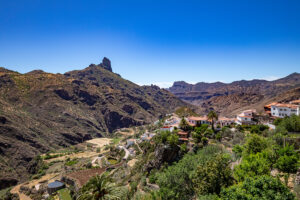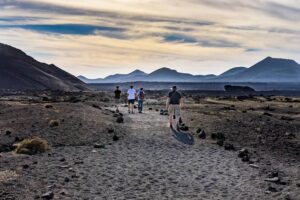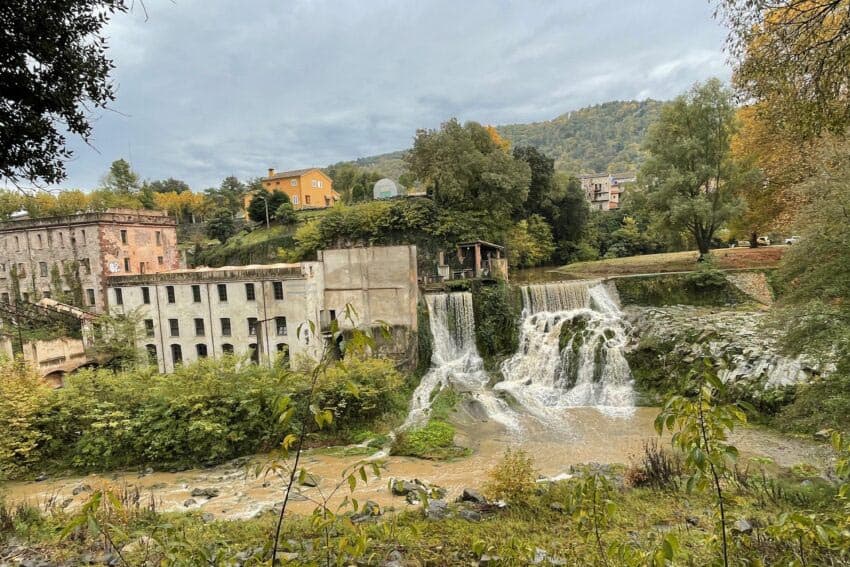
Lanzarote’s Mountains of Fire and Timanfaya National Park
By Tal Abbady

When Mario, my Spanish husband, asked which of the Canary Islands I´d like to visit for a five-day getaway with our toddler, I didn´t hesitate.
I´d only known Lanzarote, the most easterly of Spain´s seven major Canary Islands, from its cameo appearance in Pedro Almodovar´s Los Abrazos Rotos, and its molten beauty lingered in my mind for days.
Lanzarote, home of the “mountains of fire” seemed the perfect antidote to the café-fueled crowds of Madrid, our home city.
Memorable Landings in Lanzarote
The most memorable landings are the ones that make you grope for words. On our descent, there was a general hush on the plane as Lanzarote´s blue-black volcanoes and ashen beaches stretched beneath us.
Even David, my two-year-old son who had squirmed in his seat for the two-and-a-half-hour flight, gaped at the small airplane window. As it prepared to land, the plane coasted over fields of malpais, or badlands, mangled lava beds that have covered large swaths of the island since the 18th-century volcanic eruptions that resulted in its brooding, lunar landscape.
At the capital city of Arrecife, the ubiquity of the island´s volcanic lava rock and its embeddedness in daily life were clear. Pitch-black sculptural boulders stood near the entrance of Arrecife´s main airport terminal.
Once in our rental car and on the road, we saw that the gnarled rock decorated the front porches of many of the white, sun-struck homes we passed.
Small, urban murals of the stuff bordered hotels and residential buildings, creating a sharp contrast between the enameled white of the island´s squat architecture and the black lava. Knee-high walls of volcanic rock also protected grapevines, lettuce, and onion plantations from the trade winds that gust through the island from Africa, just 80 miles offshore.
Lava Formations
Lava formations and smoothed rocks mottled the dark sands and cut through teal-blue waves as the sun, casting a purplish light over the island, began to set. We drove less than twenty minutes to Los Pocillos in Puerto del Carmen and checked into Teneguia Apartments, a low-cost aparthotel with a mountain view from the sliding glass door. Our poolside, ground-floor apartment came fully furnished and had a fully equipped kitchen.
The hotel also provided us with a large pack-and-play-style, portable crib for David, who quickly learned how to feed coins into the coin-operated television set. At two, and with parents who have families dispersed among different countries, David is a jet setter.
Apartment Amenities
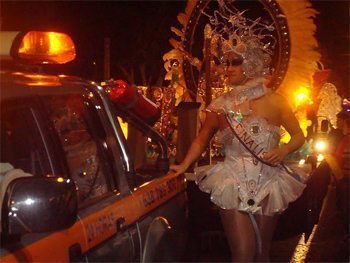
My husband and I decided a while back that the homelike conveniences of an apartment-style hotel lighten the schlep of traveling with a baby in tow.
When David cries out for milk or a snack at an unexpected hour, I simply open the refrigerator door. We also spare ourselves the manic restaurant outings that can rack up a trip´s expenses and become grinding when you´re chasing after a toddler. We decided we´d split our meals between restaurant fare and home cooking.
Walking Avenida Las Playas
On our first evening, after shopping at a nearby supermarket and eating a pasta dinner “at home,” we walked along Avenida las Playas, Puerto del Carmen´s main beach promenade.
We strolled by a bright pageant of surf shops, upscale bars, pubs, pizza parlors, Chinese restaurants, and faux-Old West-style joints. An aloe shop sold shampoos, creams, gels, and other balms made from the pulp of Lanzarote´s aloe plant. A few steps away I discovered Marysol, which sells moderately priced jewelry made with black and red lava rock, and indulged in a pair of black lava earrings.
After breakfast the next morning, we headed over to Timanfaya National Park, a stretch of geological formations borne of a series of volcanic eruptions that scarred the island from 1730 to 1736, and again in 1824. Many inhabitants fled before the upheaval, but a local priest, Don Andres Lorenzo Curbelo stayed behind and recorded one of the best-known chroniclers of the event.
In a 1731 entry, Curbelo described how “a mountain emerged from the bowel of the earth.” Dubbed the Mountains of Fire, the actual area of devastation is close to 110 miles, but visitors are restricted to short bus tours that wind through a smaller section of the volcanic cones, lava domes, or hornitos and petrified earth beneath which lava still sizzles in some spots.

Tragically beautiful and seemingly inhospitable to life, the park is home to beetles, lizards, Egyptian vultures, and the bright, enduring lichen that carpet the lava flows.
After taking in the park´s fantastic beauty in an air-conditioned tour bus, we lingered at the park´s summit and impressive eatery.
The circular El Diablo Restaurant, designed by Cesar Manrique, a Lanzarote-born artist, and preservationist whose imprint is on most of the island´s major sites and who helped conceive the tour-bus route through Timanfaya, has views of the volcanic park and serves fish and meat grilled over a natural volcanic pit.
We didn´t eat but instead downed strong jolts of coffee at the restaurant´s spacious bar.
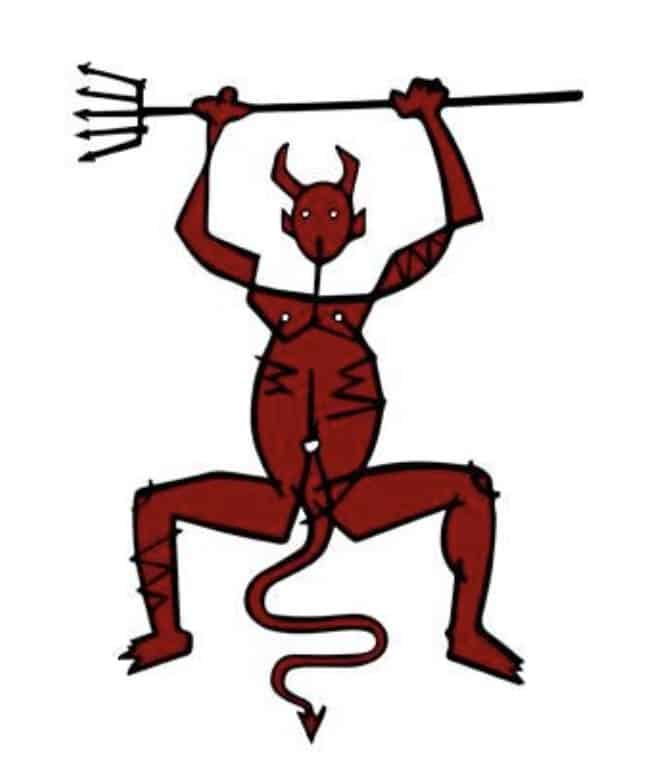
At the gift shop, it was clear Manrique´s spread-eagled devil, which greets visitors at the park´s entrance, is the scorched island´s symbol, a talisman branded on mugs and t-shirts sold throughout Lanzarote.
Riding a Camel
We couldn´t leave Timanfaya without appreciating its beauty from one last vantage point – the back of a camel. Telling ourselves we didn´t mind acting so glaringly like tourists on behalf of our two-year-old, we stopped at the camel rides just past the park entrance for a twenty-minute ride along Timanfaya´s foothills.
From the 16th to 19th centuries, Spaniards in Lanzarote used camels to travel and transport cargo, though today the animal´s lot is to amuse visitors such as ourselves.

Nestled comfortably in our box-like saddles, the line of camels staggering along, we got a view of Timanfaya´s slopes one last time. Afterward, I asked one of the guides, Antonio Morales, a Lanzarote native, or Majo, if he was unfazed by the island´s spectacular beauty.
He wasn´t, but what struck him more, he said, was how his ancestors managed to cultivate and build on the land after the eruptions. “It´s an island of survivors,” he told me.
After the awesome sight of Timanfaya, we were ready to unwind on a beach. Stopping for lunch at Brisa Marina in Playa Blanca, Costa Teguise, we scarfed down grilled Bocinegro fish, locally caught and accompanied by the island´s nutty, golf-ball-sized papas arrugadas, or wrinkled potatoes, boiled with coarse salt and served with red and green mojo sauces.
Just a short drive south of Brisa Marina, we were at the entrance of the Monumento Natural de Los Ajaches, more commonly known as the beaches and coves of Papagayo. Even after lunch, the mountain-fringed shores and views of nearby Fuerteventura island were well worth the mild beating we took driving on the rutted road that leads to Papagayo beach.
Once we were down a small embankment, with David safely in my husband´s arms, Papagayo´s dark sands met our feet. After exploring the black lava grotto on one end of the narrow beach,
Quick Dip
I plunged into the brisk, hazel water for a quick swim. Despite the trade winds´ constant bluster, we were warmed by a hazy sun and stayed until sundown. That night I slept deeply, my mind settled on images of lava domes and green waters.
The next morning, we headed to Jameos Del Agua, a natural volcanic tube filled with gleaming seawater and home to a rare, blind albino crab.

The stunning site includes snack bars bored into the volcanic rock; narrow footpaths that pass through the cathedral-like lava tunnel and ascend into layers of colorful vegetation; a glistening pool fit for a James Bond movie and a grotto molded into an auditorium used for concerts.
It is one of Cesar Manrique´s memorable, organically designed creations. Manrique, a proponent of ecologically friendly tourism who was killed in a car accident in 1992, fought to stave off the golf-club and resort frenzy that robbed some of the other islands of their uniqueness. He was successful enough so that development has not disfigured the Lanzarote´s sprawling beaches and ascetic splendor.
Driving a short distance from Jameos De Agua, we stopped at Cueva de Los Verdes, or Cave of The Greens, the other end of the same lava tunnel as Jameos. Though the guided group included couples with small babies strapped to their chests, Mario, who had visited Lanzarote before, stayed behind with David while I ducked into the cave. According to our guide and the local lore, Los Verdes were former owners of the land where the cave is located.
They, along with other local families in the 16th an 17th centuries, used the subterraneous volcanic galleries to hide from ransacking pirates. Today, lighting designed by artist Jesus Soto brings out the stunning red and bronze tones of the caves´ interior walls.
As we descended from one gallery to the next, squatting in places where the grooved ceiling was precariously low, it was obvious why God´s Murmur and Throat of Death are names used to describe sections of the cave where the wind whistles faintly and darkness gapes.
Driving Mountain Roads
The next day unfolded at a slow, leisurely pace. We drove along Lanzarote´s narrow mountain roads to the vertiginous heights of the famous vista, Mirador del Rio. From that summit, the ocean and sky meshed into a limitless blue, and Lanzarote´s volcanoes rose like giant camel humps.
Before going back to relax at our hotel, we stopped at Manrique´s Jardin de Cactus, an amphitheater-style, open-air exhibit of cactus plants from places as disparate as South Africa, California, Madagascar and other parts of the world.
On our last full day, we drove south to Playa de Famara, a churning, surfer´s dream of a beach, and were shepherded by the ocean winds on a walk along the shore while watching the white, roiling surf. On the road to La Santa, a nearby town, the ocean rose in spectacular displays of cascading, turquoise-blue waves that were worth a photo stop.
Hungry from our beach walk, we stopped at Rio Azul restaurant in La Santa for grilled Vieja fish, papas arrugadas and a local dessert called bienmesabe (it tastes good to me), that consists of a rich paste made from caramel, cake crumbs and nuts served over vanilla ice cream. Sated and relaxed, we drove back to Los Pocillos to rest before heading over to Arrecife for one of the annual carnival parades – Gran Desfile de Carrozas, or Great Float Parade.
Despite the chill that settled over the evening, the floats, band music, and local pageantry, including a Michael Jackson sighting and a Barbie-in-the-flesh queen, awed our two-year-old.
Before heading to the airport on our final day, we walked along the beach promenade of Arrecife, and stopped for a cold beer at a small, French café, where David munched on a buttery croissant. We lingered at the café, knowing home and work routines would soon fray the dream of Lanzarote. My thoughts went back to the severe earth and cratered beauty of Timanfaya.
It was time to head home, but the island was already beckoning me back.
More Information
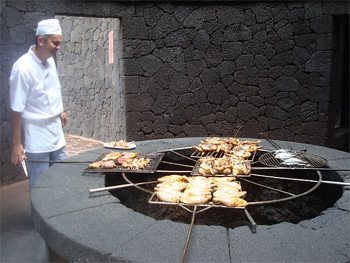
Most sites, such as Timanfaya, Jameos del Agua, and Cueva de Los Verdes, charge a small entrance fee. For information, call the Patronato de Turismo at 011-34-928-81-1762. English speakers are available.
The website of the Centros de Arte, Cultura y Turismo of Lanzarote is also a good source of information that can be accessed in English. Go to www.centrosturisticos.com
WHERE TO STAY:
Apartamentos Teneguia, Calle Finlandia 4, Los Pocillos section of Puerto del Carmen
Tel: 011-34-928-510-419. We paid around 150 euros (roughly $205) for five nights, but rates vary depending on the season.
WHERE TO EAT:
Brisa Marina Restaurant, Avenida Maritima 24, Playa Blanca: 011-34-928-517-206
Rio Azul Restaurant, Calle El Marinero 7, La Santa: 011-34-660-427-521
- These 9 U.S. National Parks Require Reservations in 2024 - April 17, 2024
- Take a Hike in Olympic National Park - April 17, 2024
- The Wild Mississippi: 2340 Miles Across Ten States - April 8, 2024


